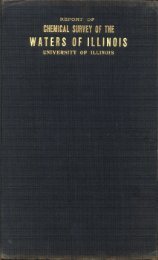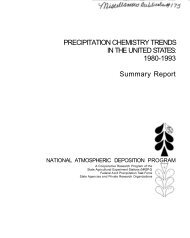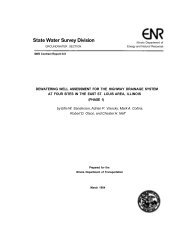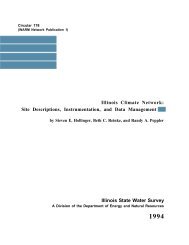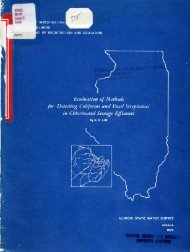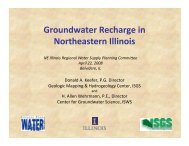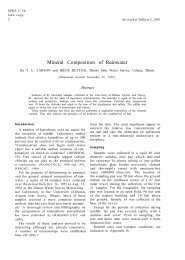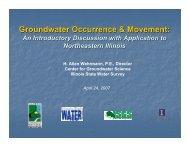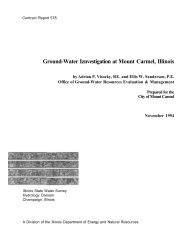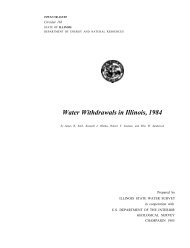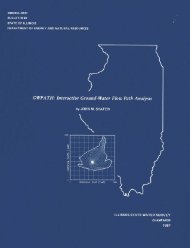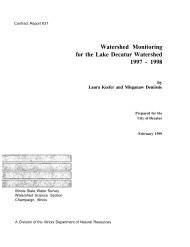Coliforms and fecal streptococcus in the Illinois River at Peoria ...
Coliforms and fecal streptococcus in the Illinois River at Peoria ...
Coliforms and fecal streptococcus in the Illinois River at Peoria ...
Create successful ePaper yourself
Turn your PDF publications into a flip-book with our unique Google optimized e-Paper software.
<strong>Coliforms</strong> <strong>and</strong> Fecal Streptococcus<br />
<strong>in</strong> <strong>the</strong> Ill<strong>in</strong>ois <strong>River</strong> <strong>at</strong> <strong>Peoria</strong>, 1971-1976<br />
by S. D. L<strong>in</strong> <strong>and</strong> Ralph L. Evans<br />
SUMMARY AND CONCLUSIONS<br />
1. Bacterial samples for <strong>the</strong> Ill<strong>in</strong>ois <strong>River</strong> <strong>at</strong> <strong>Peoria</strong> were collected weekly dur<strong>in</strong>g <strong>the</strong> 5-year<br />
period June 1971 to May 1976 <strong>and</strong> exam<strong>in</strong>ed for total coliform <strong>and</strong> <strong>fecal</strong> coliform densities. Exam<strong>in</strong><strong>at</strong>ion<br />
for <strong>fecal</strong>-<strong>streptococcus</strong> densities began <strong>in</strong> June 1972.<br />
2. Samples for chemical analyses were collected <strong>and</strong> measurements for physical characteristics-<br />
. were performed weekly from December 3, 1973, to May 24, 1976.<br />
3. Vari<strong>at</strong>ions <strong>in</strong> bacterial densities were substantial dur<strong>in</strong>g <strong>the</strong> 5-year period as shown from TC,<br />
FC, <strong>and</strong> FS d<strong>at</strong>a <strong>in</strong> figures 1, 2, <strong>and</strong> 3, respectively. The density (counts/100 ml) th<strong>at</strong> is likely to<br />
. occur 50 percent of <strong>the</strong> time was about 7900 for TC, 240 for FC, <strong>and</strong> 120 for FS.<br />
4. The <strong>in</strong>spection of <strong>the</strong> bacterial density with precipit<strong>at</strong>ion <strong>in</strong> <strong>the</strong> <strong>Peoria</strong> area suggested th<strong>at</strong><br />
about 50 percent of <strong>the</strong> time <strong>in</strong>creases <strong>in</strong> bacterial densities are associ<strong>at</strong>ed with a precipit<strong>at</strong>ion event.<br />
The associ<strong>at</strong>ion is not sufficient to conclude th<strong>at</strong> <strong>the</strong>re is a clear-cut rel<strong>at</strong>ionship between <strong>the</strong> two.<br />
5. From a comparison of <strong>fecal</strong> coliform densities <strong>at</strong> <strong>Peoria</strong> with Rule 302(g) of regul<strong>at</strong>ions<br />
- govern<strong>in</strong>g acceptable w<strong>at</strong>er quality <strong>in</strong> Ill<strong>in</strong>ois streams, it is concluded th<strong>at</strong> compliance with <strong>the</strong> 200<br />
per 100 ml stipul<strong>at</strong>ion is achieved about 44 percent of <strong>the</strong> time while compliance with <strong>the</strong> 400 per<br />
100 ml stipul<strong>at</strong>ion is achieved about 25 percent of <strong>the</strong> time.<br />
6. On <strong>the</strong> average about 7.1 percent of <strong>the</strong> total coliform densities consisted of <strong>fecal</strong> coliform.<br />
- This compares with 8.8, 9.5, <strong>and</strong> 14 percent observed <strong>in</strong> <strong>the</strong> Upper Ill<strong>in</strong>ois <strong>River</strong>, Spoon <strong>River</strong>, <strong>and</strong><br />
<strong>the</strong> Ohio <strong>River</strong>, respectively.<br />
7. There is a considerable vari<strong>at</strong>ion <strong>in</strong> FC/TC r<strong>at</strong>ios. The lower r<strong>at</strong>ios occur <strong>in</strong> <strong>the</strong> w<strong>in</strong>ter <strong>and</strong><br />
spr<strong>in</strong>g because of <strong>in</strong>creases <strong>in</strong> TC, while <strong>the</strong> higher r<strong>at</strong>ios occur <strong>in</strong> <strong>the</strong> summer <strong>and</strong> fall because of<br />
<strong>in</strong>creases <strong>in</strong> FC.<br />
8. FC/FS values were used to determ<strong>in</strong>e <strong>the</strong> likely source of <strong>fecal</strong> bacteria. Group<strong>in</strong>g <strong>the</strong><br />
bacterial density d<strong>at</strong>a on <strong>the</strong> basis of seasons <strong>in</strong>dic<strong>at</strong>es th<strong>at</strong> <strong>fecal</strong> contam<strong>in</strong><strong>at</strong>ion is derived from<br />
human sources <strong>in</strong> 41 percent of <strong>the</strong> samples collected durihgvjune,. July, <strong>and</strong> August — <strong>the</strong> warm<br />
wea<strong>the</strong>r months.<br />
9. Efforts to def<strong>in</strong>e rel<strong>at</strong>ionships between bacterial densities <strong>and</strong> 17 chemical parameters<br />
observed <strong>at</strong> <strong>the</strong> po<strong>in</strong>t of sample collections were not successful.<br />
10. A time series analysis suggests th<strong>at</strong> total coliform densities will cont<strong>in</strong>ue to <strong>in</strong>crease with time<br />
<strong>in</strong> <strong>the</strong> river <strong>at</strong> <strong>Peoria</strong>. On <strong>the</strong> o<strong>the</strong>r h<strong>and</strong>, <strong>fecal</strong> coliform <strong>and</strong> <strong>fecal</strong> <strong>streptococcus</strong> densities will decl<strong>in</strong>e<br />
-slightly.<br />
11. In a situ<strong>at</strong>ion where TC densities are expected to <strong>in</strong>crease but FC <strong>and</strong> FS densities are to rema<strong>in</strong><br />
stable or decrease, bacteria of <strong>fecal</strong> orig<strong>in</strong> are not <strong>the</strong> source of <strong>in</strong>creas<strong>in</strong>g TC densities.,The<br />
- probable source is bacteria orig<strong>in</strong><strong>at</strong><strong>in</strong>g from <strong>the</strong> soil or Aerobacter aerogenes aftergrowths;<br />
12. The fact th<strong>at</strong> <strong>fecal</strong> coliform densities <strong>at</strong> <strong>Peoria</strong> exceed w<strong>at</strong>er quality st<strong>and</strong>ards most of <strong>the</strong><br />
time is not surpris<strong>in</strong>g, s<strong>in</strong>ce most Ill<strong>in</strong>ois streams do not meet bacterial st<strong>and</strong>ards. Wh<strong>at</strong> is surpris<strong>in</strong>g<br />
is th<strong>at</strong> <strong>the</strong> bacterial quality of <strong>the</strong> Ill<strong>in</strong>ois <strong>River</strong> <strong>at</strong> <strong>Peoria</strong> is as good if not better than th<strong>at</strong> <strong>in</strong> one of its<br />
tributaries, <strong>the</strong> Spoon <strong>River</strong>, despite a sewered popul<strong>at</strong>ion upstream of <strong>the</strong> Peroia sampl<strong>in</strong>g st<strong>at</strong>ion of<br />
about 10 times th<strong>at</strong> of <strong>the</strong> Spoon <strong>River</strong>. This suggests th<strong>at</strong> <strong>the</strong> assimil<strong>at</strong>ive capacity of stream w<strong>at</strong>ers<br />
<strong>and</strong> nonpo<strong>in</strong>t sources are important factors <strong>in</strong> assess<strong>in</strong>g <strong>the</strong> bacterial quality of streams.<br />
1



